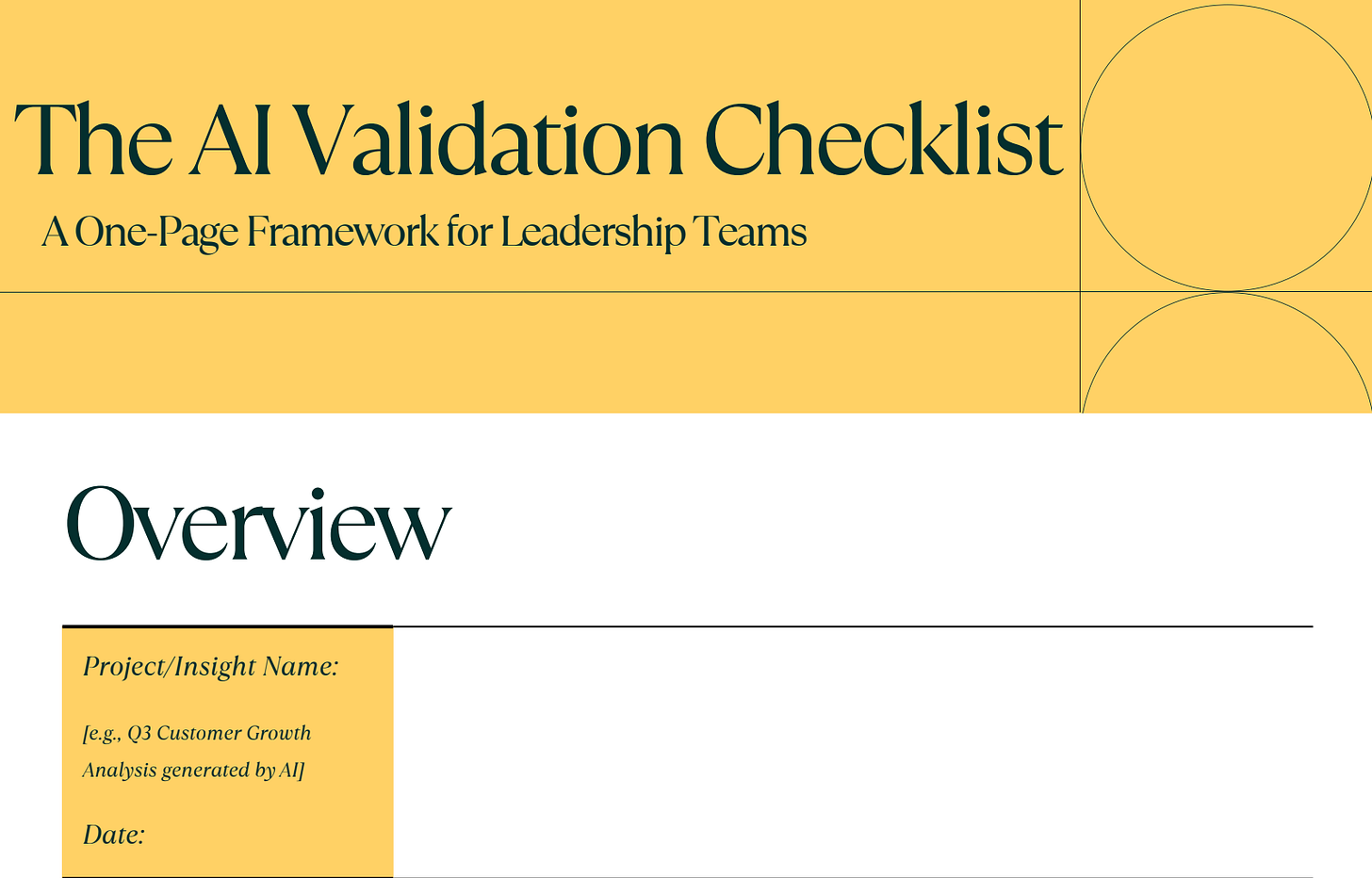A Leader’s Framework for Validating AI Outputs
How to build intelligent skepticism into your AI decision-making process (Guest)
Thanks for reading! To access our community, full prompt library, coaching, and AI tools saving leaders 5-10 hours per week, check out our Premium Hub.
Have you ever received a beautifully formatted AI analysis that felt almost too good to be true? Perfect charts, decisive recommendations, and that golden opportunity you've been searching for, all wrapped in the kind of clarity that cuts through weeks of uncertainty. It's intoxicating.
But then comes the question I ask myself: what if it's wrong? Not obviously wrong, but subtly, dangerously wrong in ways that could derail your strategy and erode trust with your team.
This is the challenge every leader faces in our AI-driven world. We need the insights, but we can't afford to be blindsided by intelligent-sounding mistakes. The question isn't whether to use AI (that ship has sailed), but how to lead with both confidence and wisdom when AI is involved.
Today's exploration comes from Hodman Murad, a data scientist with over a decade of experience translating complex analytics into practical leadership frameworks. Through her publication The Data Letter, Hodman helps leaders navigate the intersection of data, AI, and strategic decision-making.
What I appreciate about Hodman's framework is that it doesn't require you to become a data scientist. Instead, it gives you the structured skepticism every leader needs to harness AI's power without falling into its traps.
In this article, you'll discover:
Why AI-generated insights can be compelling, well-formatted, and completely wrong
The 4-Layer Validation Protocol that requires no technical background
How to build intelligent skepticism into your team's decision-making process
Specific red flags that signal when AI analysis needs deeper scrutiny
A practical checklist you can use in your next strategic meeting
Here's Hodman...
An AI-generated strategy can feel like a lighthouse in a foggy world of constant uncertainty. It arrives with the kind of clarity and confidence we crave: crisp charts, definitive conclusions, and bold, unambiguous recommendations. When it identifies a hidden golden opportunity, a chance to capture an entirely new customer segment, the appeal is irresistible. The momentum to act, to finally have a clear path forward, becomes powerful.
But what if it’s built on an invisible flaw? Not a dramatic error, but a subtle one. A misapplied statistic, a logical leap trained on outdated information, or a complete hallucination of a customer segment that doesn’t exist.
This is the trap of the AI era: plausible, compelling, and wrong. The failures aren’t clumsy robots; they are intelligent and perfectly formatted. Analyses that are built on faulty foundations. Making a basic strategic decision on this unchecked output is a fast track to eroded trust, wasted resources, and costly missteps.
The hard truth for leaders is this:
You are not responsible for being a data scientist, but you are entirely responsible for the process that validates what your data and your AI tell you.
Assuming accuracy without process is no longer an IT issue; it’s a leadership failure.
Here’s the empowering part: safeguarding your team from these errors doesn’t demand a technical background. You need a disciplined framework. This article provides a non-technical, actionable protocol to ensure your AI initiatives are grounded in reality, not just compelling fiction.
Introducing The 4-Layer Validation Protocol
Think of this as a strategic sieve. Before any AI-generated insight informs a decision, it must pass through these four layers of scrutiny. This isn’t about technical code review; it’s about applied strategic thinking.
Layer 1: Start with a Reality Check
This is your first and most potent line of defense. It requires no data skills, only deep business acumen and intuition.
Key Question: Does this conclusion align with fundamental business logic?
AI operates on patterns and probabilities, not wisdom. It can identify a correlation but is hopeless at understanding causation without a human context. Your job is to bring that context.
Red Flags:
Unexplained 10x Growth: An AI model might identify a spike in a tiny, insignificant product line and extrapolate it into a significant trend. Your gut knows that a product that has generated $1k in revenue for years won’t suddenly do $10k without a massive, identifiable reason.
Ignoring Known Constraints: The AI suggests ramping up production based on demand forecasts, but you know your supply chain is capped for the next quarter. The AI doesn’t know that.
Contradicting Core Truths: The analysis suggests your most loyal customer segment is suddenly abandoning you, but your frontline sales team reports record engagement. The AI might be analyzing flawed data.
Your Action: If the conclusion feels off, it probably is. Halt. Do not proceed to more complex layers until this fundamental dissonance is resolved. This often means going back to the team and asking, “Walk me through the data behind this. Help me understand why this makes sense.”
Layer 2: Interrogate the Source
AI models, especially LLMs, are infamous for hallucination, confidently generating information that is fabricated. This layer moves from gut feeling to a basic audit of the facts presented.
Key Question: Do the specific entities, segments, and facts cited by the AI actually exist in our source systems?
Red Flags:
Invented Segments: The report refers to high-value customers in the Northwest region aged 25-34 years old. Do you even have a customer segmentation model that defines high value this way? Does your CRM data support the existence of a meaningful cohort in that exact demographic and geographic slice?
Phantom Products/Categories: The analysis discusses sales trends for a product named X-Pro Premium Edition. You only sell the X-Pro. The AI may have conflated a product name from its training data with your actual inventory.
Misattributed Sources: The AI cites a specific internal report or data source. Does that report actually exist? Is the data fresh?
Your Action: Demand traceability. Ask your team to show you the raw data points that led to the conclusion. “Show me the list of customers in that segment.” “Pull the sales record for that exact product.” This simple act of verification catches a large percentage of AI’s most dangerous errors.
Layer 3: Audit the Metrics
This is where we check the mathematical integrity of the analysis. You don’t need to run the numbers yourself, but you need to ask questions that ensure someone did.
Key Question: Are the core calculations, definitions, and key metrics sound and consistent?
AI can manipulate numbers correctly, but it can easily use the wrong numbers or apply flawed logic if the initial prompt was poor.
Red Flags:
Shifting Definitions: In one section of the report, monthly active users might include free trials, while in another, they might not. Is the AI using a consistent definition throughout?
Misapplied formulas: The AI calculates a lifetime value that is dramatically higher or lower than usual. How was it calculated? Was revenue mistakenly used instead of profit?
Ignoring Base Sizes: The AI highlights a 100% increase in engagement, from 2 users to 4. A statistically meaningless finding is presented as a significant trend.
Your Action: Ask clarifying questions about the math. “How did we arrive at this LTV number?” “Can you walk me through the formula?” “What was the sample size for this analysis?” “Is this metric calculated the same way it is in our quarterly board reports?” You’re enforcing discipline and consistency.
Layer 4: Seek Full Context
This is the highest order leadership function. It ensures the insight isn’t just internally sound, but also makes sense in the wider world.
Key Question: Does this insight logically align with known market conditions, operational realities, and historical trends?
Red Flags:
The Market Blind Spot: The AI predicts a surge in demand, but you know a major competitor is launching a superior product next. News that wasn’t in the data the AI trained on.
The Operational Impossibility: The AI recommends optimizing the delivery fleet for 2-hour deliveries, but your operational team knows your warehouse sorting system can’t physically support that.
The Historical Anomaly: If the conclusion stands in stark contrast to historical trends, it warrants careful investigation. This doesn’t mean it’s wrong, but it does mean you must identify the new variable that accounts for the change, whether in the market, your data, or your model.
Your Action: Facilitate a cross-functional discussion. Bring the AI’s output to your heads of Operations, Marketing, and Sales. “This is what the model is telling us. Based on what you see on the ground, does this fit the situation? What are we missing?” You are using AI as an input to human wisdom, not a replacement for it.
Putting It Into Practice: Your AI Validation Checklist
Frameworks are useless without application. To make this protocol real, I’ve created a simple, one-page tool you can use in your next strategic meeting where an AI-generated analysis is presented.
How to use it: When a new analysis or recommendation is presented, place this page on the table. Work through the layers as a team. It transforms validation from an abstract concept into a structured, meeting-length conversation.
Leading in the Age of Intelligent Artifacts
The promise of AI isn’t that it will think for us, but that it will think with us. Our role as leaders is to bring the critical thinking, the context, and the wisdom that machines lack. By instituting a simple, repeatable process like the 4-Layer Protocol, you do more than just avoid errors.
You build a culture of intelligent skepticism and trust. You demonstrate that you value wisdom over wow-factor. And you ensure that the powerful tool of AI is accelerating your mission, not leading it astray.
The next time a perfectly formatted report lands on your desk, lead the conversation not by asking “How was this made?” but by asking “How do we know this is true?” That is the defining question of modern leadership.
Thank you, Hodman Murad!
If You Only Remember This:
AI can produce compelling, well-formatted analyses that are fundamentally flawed in subtle but dangerous ways
Your role isn't to become a data scientist, but to institutionalize intelligent skepticism in your decision-making process
The defining question of modern leadership isn't "How was this made?" but "How do we know this is true?"
AI is indeed a powerful thinking partner, but like any partnership, it requires wisdom, boundaries, and mutual accountability. Hodman's framework gives you exactly that.
How are you currently validating AI-generated insights in your organization?
PS: Many subscribers get their Premium membership reimbursed through their company’s professional development $. Use this template to request yours.
Let’s Connect
I love connecting with people. Please use the following to connect, collaborate, if you have an idea, or just want to engage further:
LinkedIn / Community Chat / Email / Medium










Great filter. Thank you Joel
Hodman’s framework is a game-changer for leaders. Structured AI validation like this keeps decisions grounded, actionable, and reliable.
For more AI trends and practical insights, check out my Substack, where I break down the latest in AI.